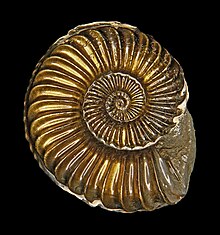
Back Ammonoidea Afrikaans أمونيت Arabic Ammonoidea AST Ammonoidealar Azerbaijani Аманіты (галаваногія) Byelorussian Амонити Bulgarian Ammonoidea BS Ammonits Catalan Ammonoidea CEB Amoniti Czech
| Ammonoids | |
|---|---|

| |
| Specimen of Pleuroceras solare, from the Lower Jurassic of Bavaria, Germany | |
| Scientific classification | |
| Domain: | Eukaryota |
| Kingdom: | Animalia |
| Phylum: | Mollusca |
| Class: | Cephalopoda |
| Clade: | Neocephalopoda |
| Subclass: | †Ammonoidea Zittel, 1884 |
| Orders | |
Ammonoids are extinct spiral shelled cephalopods comprising the subclass Ammonoidea. They are more closely related to living coleoids (i.e., octopuses, squid and cuttlefish) than they are to shelled nautiloids (such as the living Nautilus).[1] The earliest ammonoids appeared during the Devonian, with the last species vanishing during or soon after the Cretaceous–Paleogene extinction event. They are often called ammonites, which is most frequently used for members of the order Ammonitida, the only living group of ammonoids from the Jurassic up until their extinction.[2]
Ammonites are excellent index fossils, and linking the rock layer in which a particular species or genus is found to specific geologic time periods is often possible. Their fossil shells usually take the form of planispirals, although some helically spiraled and nonspiraled forms (known as heteromorphs) have been found.
The name "ammonite", from which the scientific term is derived, was inspired by the spiral shape of their fossilized shells, which somewhat resemble tightly coiled rams' horns. Pliny the Elder (d. 79 AD near Pompeii) called fossils of these animals ammonis cornua ("horns of Ammon") because the Egyptian god Ammon (Amun) was typically depicted wearing rams' horns.[3] Often, the name of an ammonite genus ends in -ceras, which is from κέρας (kéras) meaning "horn".
- ^ Klug, Christian; Kröger, Björn; Vinther, Jakob; Fuchs, Dirk (August 2015). "Ancestry, Origin and Early Evolution of Ammonoids". In Christian Klug; Dieter Korn; Kenneth De Baets; Isabelle Kruta; Royal H. Mapes (eds.). Ammonoid Paleobiology: From macroevolution to paleogeography. Topics in Geobiology 44. Vol. 44. Springer. pp. 3–24. doi:10.1007/978-94-017-9633-0_1. ISBN 978-94-017-9632-3.
- ^ "What is an ammonite?". www.nhm.ac.uk. Retrieved 2023-12-21.
- ^ NH 37.40.167